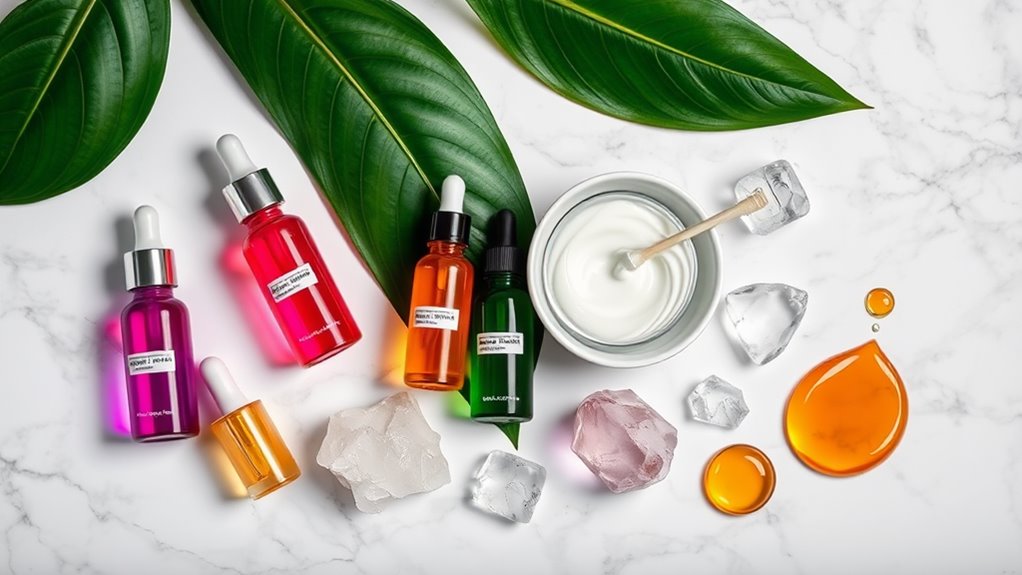Skincare Ingredients That Should Never Be Mixed
Mixing certain skincare ingredients can be a recipe for irritation and reduced effectiveness. For example, don’t combine retinol with vitamin C, as they work best separately due to their different pH levels. AHA/BHA and retinol can lead to over-exfoliation if used together. Also, try avoiding niacinamide with vitamin C, as they can neutralize each other. Stick to using strong acids and peptides at different times for optimal results. Keep exploring to learn about other ingredient pitfalls!
Retinol and Vitamin C
When you’re layering your skincare, it’s crucial to remember that combining retinol and vitamin C can lead to irritation or diminished effectiveness. Many of us seek the perfect routine to achieve that radiant glow, but mixing these two powerhouse ingredients often creates bad ingredient combos that can hurt your skin.
Retinol works its magic overnight, while vitamin C loves to shine during the day, fighting free radicals. When you mix them, the pH imbalance can make both less effective and cause redness or peeling. Additionally, using these ingredients together can result in increased skin sensitivity, which may lead to further irritation.
Instead of doubling up, consider using vitamin C in the morning to brighten your complexion, while reserving retinol for nighttime to promote cell turnover. This way, you harness the best of both worlds without the downside.
AHA/BHA and Retinol
Mixing AHA/BHA with retinol can also spell trouble for your skin. While both are powerful ingredients that promote exfoliation and cell turnover, using them together can lead to irritation and sensitivity. You might find your skin reacting with redness, peeling, or breakouts, which isn’t the goal, right? Over-exfoliation can damage your skin barrier, making it essential to be cautious with how you combine these potent ingredients.
Instead of layering them, consider using these products on alternate days or at different times of the day. For instance, you could apply your AHA or BHA in the morning and save retinol for your evening routine. This way, you still reap the benefits of both without overwhelming your skin.
Vitamin C and Niacinamide
While both vitamin C and niacinamide are celebrated for their skin-brightening and anti-aging benefits, combining them in your routine mightn’t be the best idea.
When used together, they can actually neutralize each other’s effects, leaving your skin less revitalized than you’d hoped. You may find that applying them separately delivers better results—vitamin C in the morning for that fresh, glowing boost, and niacinamide at night for its soothing and repairing qualities.
If you’re looking for a community that wisely navigates skincare, this approach resonates. Additionally, understanding product incompatibility is crucial to maximizing the effectiveness of your routine.
Remember, layering products can be tricky, and it’s okay to explore what works best for your skin. Listen to your skin’s needs and embrace a routine that feels right for you.
Benzoyl Peroxide and Retinol
Combining benzoyl peroxide and retinol in your skincare routine can lead to irritation and reduced effectiveness for both ingredients.
While benzoyl peroxide is great for targeting acne, retinol helps with skin texture and anti-aging. However, when used together, they can create a recipe for redness, peeling, and discomfort. You’ll want to ensure your skin reaps the full benefits of each product without the unwanted side effects. Additionally, using products with harmful components can exacerbate skin sensitivity and irritation.
To keep your routine effective, consider using them at different times. For example, apply benzoyl peroxide in the morning and retinol at night. This way, you can still tackle your skin concerns without compromising your skin’s health.
Exfoliating Acids and Physical Scrubs
When considering your exfoliation routine, using exfoliating acids and physical scrubs together can wreak havoc on your skin. Both methods aim to slough off dead skin cells, but combining them increases the risk of irritation, redness, and sensitivity. You want your skin to glow, not scream for help!
Physical scrubs contain gritty particles that can damage the skin’s surface, while exfoliating acids like AHAs and BHAs penetrate deeper. Mixing the two could lead to over-exfoliation, compromising your skin barrier. Instead of achieving that smooth finish, you might end up with inflamed and unhappy skin. Common skincare mistakes can greatly impact your results.
To create a balanced routine, choose one method at a time. If you’re feeling the need for a deeper cleanse, stick to a chemical exfoliant or a gentle scrub, but not both.
Tea Tree Oil and Benzoyl Peroxide
Many people turn to tea tree oil and benzoyl peroxide for their acne-fighting properties, but using them together can lead to unwanted skin irritation. If you’re part of a community that values clear skin and effective routines, it’s important to understand the potential issues with this combination.
| Aspect | Tea Tree Oil | Benzoyl Peroxide |
|---|---|---|
| Skin Type | Best for sensitive skin | Suitable for most skin types |
| Action | Antimicrobial | Exfoliates and kills bacteria |
| pH Level | More balanced | Can be drying |
| Usage | Gentle, less irritating | Can cause redness and peeling |
| Combination Effect | May negate benefits | Increased irritation risk |
Instead of layering them, consider using them at different times to minimize irritation and maximize their benefits. Additionally, knowing the common skincare mistakes can help you avoid further irritation and promote healthier skin. Your skin deserves gentle care, and making informed choices will help you feel part of a supportive skincare journey.
Hydroquinone and Retinol
While both hydroquinone and retinol are effective in addressing skin discoloration and signs of aging, using them together can lead to increased sensitivity and irritation. This combination might seem tempting, but your skin deserves better care.
When you use hydroquinone, it brightens those stubborn dark spots, while retinol boosts collagen production and smooths fine lines. However, putting them together can overwhelm your skin, resulting in redness, peeling, and discomfort. You don’t want to sacrifice your skin’s health for faster results.
If you’re keen on incorporating both into your routine, why not stagger their use? Apply hydroquinone for a few weeks, then switch to retinol. This way, your skin can reap the benefits without the chaos.
Always remember to prioritize your skin’s well-being over quick fixes. Embrace a routine that respects your unique beauty, and you’ll shine with confidence!
Salicylic Acid and Alcohol
Your skincare routine can easily become complicated with the wrong combinations. Mixing salicylic acid and alcohol can lead to irritation and dryness, making your skin feel unhappy and unbalanced.
While salicylic acid is great for treating acne, exfoliating dead skin, and unclogging pores, alcohol strips your skin of its natural oils, leaving it feeling parched.
When you apply both, the alcohol can overpower the benefits of salicylic acid, leading to increased sensitivity. You might notice more redness or flakiness, which isn’t what you want from your skincare.
Instead, focus on using salicylic acid on its own or in products free of alcohol, maintaining a harmonious balance for your skin.
Choose products that complement each other, and your skin will thank you for it. Building a mindful regimen can foster a sense of community among those who share similar skin goals.
Peptides and Acids
Although peptides are known for their skin-rejuvenating benefits, combining them with strong acids can diminish their effectiveness. You might think pairing these two powerhouse ingredients will give you the ultimate glow, but that’s not the case.
Peptides work best in a balanced environment, while strong acids can strip away their protective qualities. When you mix them, you risk breaking down the peptides, making your hard-earned skincare routine less effective.
It’s crucial to listen to your skin and choose ingredients that complement each other, rather than compete. Instead of mixing peptides with acids, consider using them at different times of the day.
For example, save your acids for night usage and apply peptides in the morning. This way, you’ll still enjoy the benefits of both, allowing each to shine and work its magic. Your skin will thank you as you embrace a balanced approach to skincare!

